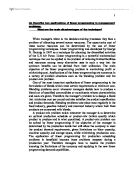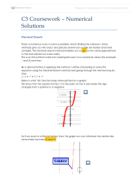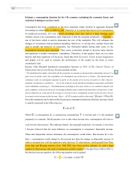Math assignment - Families of Functions.
Erik Skyllberg NEG 2003-04-03 Math assignment Families of Functions Linear Function: A linear function is formed by the slope-intercept form y = mx + b, where m is the gradient/slope, and b is the y-intercept. The greater gradient, the steeper the line will be. The gradient can be calculated through taking ?y/?x. Then you will have to use two points on each line. The y-intercept of my first linear function graph, the red line, is 2, due to that b = 2. The gradient is + 3, which also can be written 3/1. To find out that, it is possible to use the rise/run method. That means that you already know one point on the graph, the y-intercept + 2. From that point you can go upwards (rise) three units, and one unit to the right (run). You could also use the ?y/?x method to calculate the gradient. Then you take two co-ordinates on the graph. In my example I have chosen to take (-1, -1) and (0,2). I then take (2-(-1)) / (0-(-1)) = 3/1 which gives me the same answer (y2-y1 / x2-x1). In my second linear function graph, the gradient is negative, which means that my line will be moving downwards from left to right. The y-intercept is - 4 and the gradient is - 2. To calculate the slope I use the co-ordinates (-2,0) and (-1, -2). I use the ?y/?x method once again. (-2-0) / (-1-(-2)) = -(2/1). Absolute Value Function: In an absolute value function, the graph is
Describe two applications of linear programming to management problems. What are the main disadvantages of the technique?
(a) Describe two applications of linear programming to management problems. What are the main disadvantages of the technique? When managers relate to the decision-making processes they face a problem of allocating several scarce resources. The opportunity cost of these scarce resources can be determined by the use of linear programming techniques. Linear programming was developed by George B. Dantzig in 1947 as a technique for planning the diversified activities of the U.S Air Force. Linear programming is a powerful mathematical technique that can be applied to the problem of rationing limited facilities and resources among many alternative uses in such a way that the optimum benefits can be derived from their utilization. The main objective of the linear programming problem is maximizing profit or minimizing cost. Applications of the linear programming are numerous in a variety of problem situations such as the blending problem and the product-mix problem. One of the most important applications of linear programming is the formulation of blends which meet certain requirements at minimum cost. Blending problems occur whenever managers decide how to produce a blend out of specified commodities or constituents whose characteristics and costs are given. Therefore the manager's problem is to design a blend that minimizes cost per pound and also satisfies the product
Three ways of reading The Bloody Chamber.
Three ways of reading The Bloody Chamber In order to look at The Bloody Chamber as a set of interlinked stories which can be read in a variety of ways, I propose to use the ideas about language and myth as semiological systems that Barthes expounds in Mythologies. A brief account of Barthes views is therefore necessary. Barthes, following Saussure, looks upon a story as comprising a semiological structure, with three terms - signifier, signified and sign. The signifier is the linguistic unit: word, sentence, story. The signified is the thing the signifier refers to, object, thought, concept. The sign is the unity that the signified and signifier constitute for us. Barthes gives the example of someone giving a bunch of roses as a token of their affection to someone. The roses are the signifier, the signified is their passion, and the sign is the unity of signifier and signified, 'passionified' roses, which we grasp in thought. For Barthes, myth as a semiological system constitutes a second order semiological system. That is, in a myth, the signifier, the first tem in the semiology of myth, is already an item which is full of meaning, a sign. The following diagram should help to clarify Barthes point. signifier signified sign SIGNIFIER SIGNIFIED SIGN Here, the first order terms are given in lower case: signifier, signified and sign, and the second order, mythic,
Der Handschuh.
Methods of Advanced Mathematics (C3) Coursework. Task: Candidates will investigate the solution of equations using the following three methods: * Systematic search for change of sign using one of three methods: decimal search, bisection or linear interpolation. * Fixed point iteration using the Newton raphson method. * Fixed point iteration after rearranging the equation f(x) = 0 into the form x = g(x) Change of Sign This method is based on how the function has a change of sign either +ve to -ve or -ve to +ve on either side of a route when crossing the x-axis. This method relies on this fact to find the points between the positive and the negative value where there is another change from positive to negative. This can be done until a useful number of decimal places are found. To investigate this method I plan to use the function f (x) = x^3-5x+1. When I plot this it shows: From the graph we can see that routes lie on the x-axis between the values -3 and -2, 0 and 1 and 1 and 2. If I consider the function between -3 and -2 I can see I change of sign on the function from -ve to +ve. -6 -183 -5 -97 -4 -41 -3 -9 -2 5 -1 7 0 3 -1 To home in on a more accurate answer I need to investigate the decimal places between -3 and -2 x f(x) -3 -9 -2.9 -6.889 -2.8 -4.952 -2.7 -3.183 -2.6 -1.576 -2.5 -0.125 -2.4 .176 -2.3 2.333 -2.2 3.352 -2.1
GCSE Math Coursework: Triminoes
GCSE Math Coursework INTRODUCTION Triminoes is a game similar to dominoes. The game is played using triangular pieces of card. Each card has three numbers on it. Instead of drawing the triangles I will write the three numbers in brackets below. E.g. (000) (001) (002) (011) (012) (022) (111) (112) (122) (222) The aim of this investigation will be to: . Investigate the relationship between the number of Triminoe cards in a set and the largest number used in a set. 2. Investigate the relationship between the sum of all numbers on a set of Triminoe cards and the largest number used on the cards. PLANNING These are some of the formulas I will be using in order to complete the tasks: f (n) =an+b (Linear equation) f (n) =an2+bn+c (Quadratic equation) f (n) =an3+bn2+cn+d (Cubic equation) f (n) =an4+bn3+cn2+dn+e (Quartic equation) METHOD . First I am going to the number 0 and find out how much different possibilities I can make with the one number, this is obviously one. 2. I will then try two numbers 0 and 1 and find out how much different possibilities I can make with the two numbers. 3. I will continue to do this until I feel I have used enough numbers. 4. On each set of data I will record the largest number used, the sum of all the cards added together, and the number of cards used. 5. I will then make a results table. 6. I will collect the
Critically consider one invasive method and one non-invasive method of studying the brain
Critically consider one invasive method and one non-invasive method of studying the brain There are a number of invasive methods of studying the brain. One such technique is ablation and lesion production. The ablation technique involves surgically removing or destroying brain tissue. A study into this technique was conducted by Flourens (1820); who showed that the removal of thin slices of brain tissue; resulted in them displaying poor co-ordination and sense of balance but, they experienced no other difficulties. Meanwhile, lesion production involves deliberately injuring a specific area of the brain and observing the behavioural changes that occur as a result. The aim of lesion studies is to tell us something about how different areas of the brain are connected. However, there are several flaws with this invasive method of studying the brain. One of these is that, since experiments of this type are carried out on animals, the results cannot really be generalised to humans. Also, there are ethical issues involved in the use of animals in experiments that could cause distress. Other invasive methods of investigating the brain include; chemical stimulation of the brain and Electrical stimulation of the brain (ESB). One such investigation was conducted by Olds + Milner (54). In this experiment, they found that when they stimulated the hypothalamus of rats, they
Arctic Research (Maths Coursework)
MATHS COURSEWORK "ARCTIC RESEARCH" Introduction: In my investigation, a group of researchers are to set up a series of observation sites at equal distances from each other in the Arctic on the circumference of a circle of radius 50 km. The aim of my investigation is to figure out how long the researchers should be prepared to travel for on each journey. I am also to find where in the circle that the base camp should be located in order to minimize these journey times as short as possible. Using some calculations I will determine all of this taking into account that there is a strong westerly wind present constantly at all times in the area. I found out, from research, that average wind velocities in the Arctic are from 25 - 35 km/h. I will use this range in my investigation. The bearing at which the planes must depart is affected by this westerly wind therefore, this angle must be calculated. If this investigation was to be physically carried out there would be some factors that needs to be considered. In the arctic there are many mountains and obstacles a plane would have to take into account during flight. To take into account these factors in my calculations would be impractical therefore, I must establish variables that could be controlled and make some assumptions in order to make it practical. These are the variables that I must establish; * Strength of the
Decimal search.
Decimal search The equation f (x) = 0, where f (x) = x3-x2+x-2, has only one real root, but there is no simple analytical method of finding it. Therefore, a spreadsheet had been used to solve the equations numerically using decimal search. x f(x) -3 -41 -2 -16 -1 -5 0 -2 -1 2 4 3 9 The table and graph above illustrated the first approximations to the roots of the equation x3-x2+x-2=0. As the curve crosses the x-axis, f (x) changes sign, so provided that f (x) is a continuous function, once you have located an interval in which f(x) changes sign, you know that that interval must contain a root. In the table, you first take increments in x of size 1 within the interval 1<x<2, working out the value of the function x5-5x+3 for each one. You do this until you find a change of sign of f(x) between the value of x = 1 and 2 , so you should know that there is a root lying in the interval 1<x<2 on the graph. Having narrow down the interval, you can now continue 1.3<x<1.4, you could now homing in on such root using decimal search. x f(x) -1 .1 -0.779 .2 -0.512 .3 -0.193 .4 0.184 .5 0.625 .6 .136 .7 .723 .8 2.392 .9 3.149 2 4 * Tabulate f (x) for 1<x<2 with increments in x of 0.1, a change of sign reveals that 1.3<?<1.4. * Tabulate f (x) for 1.3<x<1.4 with increments in x of 0.01, a change of sign gives 1.35<?<1.36 x f(x) .3 -0.193 .31
Growing Squares
Growing Squares I have decided to find a formula to find the nth term. To help me find the nth term I shall compose a table including all the results I know. Pattern Number Number of Squares st Difference 2nd Difference 4 4 2 5 8 3 3 4 2 4 25 The 2nd difference is constant; therefore the equations will be quadratic. The general formula for a quadratic equation is an2 + bn +c. The coefficient of n2 is half that of the second difference Therefore so far my formula is: 2n2 + [extra bit] I will now attempt to find the extra bit for this formula. Pattern Number Extra Bit st Difference 2nd Difference 2 6 4 2 8 0 3 8 4 4 4 32 From my table of results I have found the formula to be 2n2 + 2n + 1 I will now check my formula by substituting a value from the table in to my formula: E.g. n = 2 Un = 2 (2) 2 - 2 (2) + 1 = 8. For Diagrams 1 - 4 I can see a pattern with square numbers. The diagrams numbers squared added to one less than the diagram number squared gives the correct number of squares. For diagram n it should be: Un = (n - 1) 2 + n2 (n - 1)(n - 1) + n2 n2 - n - n - n + 1 + n Un = 2n2 - 2n + 1 This is correct. Growing Hexagons I will now repeat my investigation, and change the original shape of the square to hexagons, and try to find the formula as before. I shall start by finding the width of each hexagon. Pattern Number (n)
Using Decimal search
Pure 2 Coursework Using Decimal search In this investigation, I have chosen x^5-14x+2=0. Such an equation cannot be solved algebraically. The following graph represents y= f(x): - Graph 1 - The graph shows me that x^5-14x+2=0 has three roots, lying in the intervals (-2,-1) , (0, 1) , (1,2). X -3 -2 -1 0 2 3 Y -199 -2 5 2 -11 6 203 Within the change of sign methods, decimal search method shall be used to find out an approximate value for roots of x^5-14x+2=0. In this method I first take increments of x of size 0.1 within the interval (1,2). I do this until I find a change in sign. X .1 .2 .3 .4 .5 .6 .7 .8 .9 Y -11 -11.78 -12.31 -12.48 -12.22 -11.40 -9.91 -7.6 -4.3 0.16 There is a sign change, and therefore a root, in the interval (1.8,1.9). I can now continue with increments of 0.01 within the interval (1.8,1.9). X .8 .81 .82 .83 .84 .85 .86 .87 .88 .89 .9 Y -4.3 -3.91 -3.51 -3.09 -2.66 -2.23 -1.77 -1.31 -0.83 -0.34 0.16 This shows that the root lies in the interval (1.89,1.90). We can express this information as, the root can be taken as 1.895 with maximum error of + 0.005 This can be shown graphically: - Graph 2 - I have also chosen 10x^3-2.5x+0.2=0 which again cannot be solved algebraically. The following graph represents y=f(x) - Graph 3 - The graph shows me that 10x^3-2.5x+0.2=0 has















